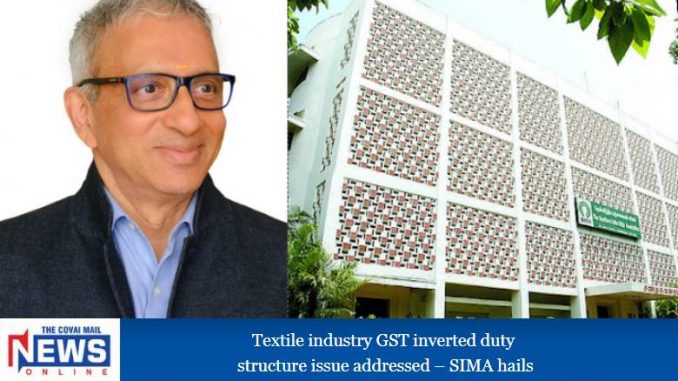
Ravi Sam, Chairman, The Southern India Mills’ Association (SIMA) thanked the Prime Minister, Minister of Finance and Minister of Textiles for addressing the long awaited GST inverted duty issue in the textile industry.

He stated that as the GST rate on MMF fibre has been reduced from 18% to 12%, it would reduce the cost of finished goods. He said that the recently announced Production Linked Incentive Scheme for certain MMF fabrics, garments and technical textiles, extending the incentive ranging from 7% to 15% based on the incremental turnover for five years, the scheme warranted two pre-requisites viz., removal of anti-dumping duty on MMF raw materials and fibres and also addressing the inverted duty issues.
SIMA Chairman has said that the Government has successfully fulfilled both the pre-requisites and hoped that the PLI scheme would become a success. He has added that though PLI scheme aims at creating 40 to 50 global champions in textile trade with higher scales of operations, the reform would greatly strengthen MMF value chain to become globally competitive.
Ravi Sam has stated that globally, the consumption of cotton and MMF fibre is in the ratio of 35:65 while the same is reverse in India, as the MMF raw materials and fibres were expensive due to anti-dumping duties and inverted duty issues. He has added that MMF would become the growth engine in the coming years for the growth of the textile industry in India.
He stated that retaining 5% GST rate for cotton and cotton yarn would greatly benefit the cotton farmers. He also thanked the Government for addressing the inverted duty structure for dyeing and printing of textile and textile products job work by increasing the rate from 5% to 12%. He has said that this would greatly benefit the textile processing segment, the weakest link in the entire textile value chain and job work services account over 80% of the textile manufacturing activities.
SIMA Chief has stated that 12% GST on all garments and fabrics would increase the cost for common man, especially the people below the poverty line and felt that cotton fabrics and garments below Rs.1000/- could have been retained at 5% GST rate. He has also stated that the increase in GST rates at fabric and garment stage would increase the working capital burden for the fabric and garment manufacturers.
